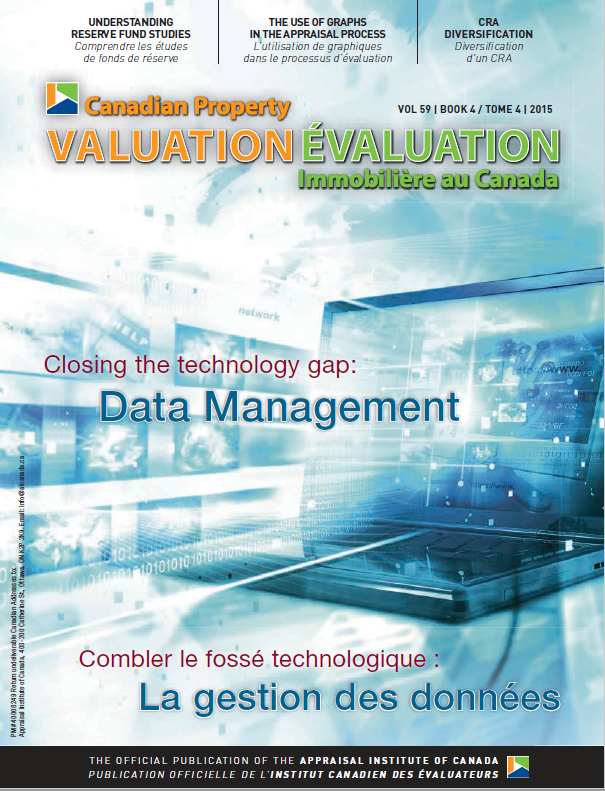When Chattels Become Real Property
Canadian Property Valuation Magazine
Search the Library Online

By John Shevchuk, C.Arb, AACI(Hon)
Volunteer Member, Appeal Sub-committee, Barrister & Solicitor
In the sale of real property and in landlord and tenant arrangements, it is quite common for questions to arise over the ownership of buildings, structures and other items that are on the land at the time of sale or at the end of a tenancy. The question revolves around whether a particular thing is a chattel or has become part of the real property.
In Scott v. Filipovic[i] [Scott], the British Columbia Court of Appeal considered competing claims to blueberry bushes planted by the tenant in a commercial tenancy. The landlord took the position that the tenant had abandoned the lease. The landlord took over the property and would not allow the tenant onto the property to remove the blueberry plants. The tenant sued the landlord for breach of the lease and conversion in relation to the blueberry plants. The tenant argued that the intention of the landlord and the tenant was that the blueberry plants remain chattels and not become part of the land.
The lease contained a provision that, at the end of the term, the land was to be cleared and replanted with Timothy grass. The tenant said that this was evidence that the parties intended the blueberries be regarded as chattels. The Court of Appeal disagreed and explained the law relating to chattels becoming part of the real property.
The Court of Appeal relied upon the Ontario Divisional Court decision in Stack v. T. Eaton Co.[ii] [Stack] that has long been relied upon for the factors to be considered in determining if property is a chattel, and, therefore, personal property, or forms part of the real property. In Stack, the issue was ownership of certain shop fittings (shelving attached to walls) and gas and electric fittings in a building that was the subject of a sale. Meredith C.J., writing for the court, stated the following:
1) I take it to be settled law:
2) 1. That articles not otherwise attached to the land than by their own weight are not to be considered as part of the land, unless the circumstances are such as show that they were intended to be part of the land.
3) 2. That articles affixed to the land even slightly are to be considered part of the land unless the circumstances are such as to show that they were intended to continue chattels.
4) 3. That the circumstances necessary to be shown to alter the prima facie character of the articles are circumstances which show the degree of annexation and object of such annexation which are patent to all to see.
5) 4. That the intention of the person affixing the article to the soil is material only so far as it can be presumed from the degree and object of the annexation.
6) 5. That even tenants’ fixtures, put in for the purposes of trade, form part of the freehold, with the right, however, to the tenant, as between him and his landlord, to bring them back to the state of chattels again by severing them from the soil, and that they pass by a conveyance of the land as part of it, subject to this right of the tenant.
The shelving and utility fittings were held to be part of the land.
The “object and degree of the annexation” was described by the Supreme Court of Canada in Haggert v. Brampton (Town):[iii]
In passing upon the object of the annexation, the purposes to which the premises are applied may be regarded; and if the object of setting up the articles is to enhance the value of the premises or improve its usefulness for the purposes for which it is used, and if they are affixed to the freehold even in a slight way, but such as is appropriate to the use of the articles, and showing an intention not of occasional but of permanent affixing, then, both as to the degree of annexation and as to the object of it, it may very well be concluded that the articles are become part of the realty . . .
In Scott, the Court of Appeal held that the term of the lease requiring removal of the plants was not the type of evidence that establishes intent. Rather, the evidence must be of the type that establishes objective intent. The evidence must inform third parties viewing the situation of the intention of the parties one way or the other. The factors set out in Stack provide the basis for determining if property has become a fixture. The court quoted the following passage from Anger & Honsberger: Law of Real Property:[iv]
A chattel becomes a fixture by implication. Thus, whether or not an object has become a fixture is determined by the application of established rules to the facts of the case rather than by agreement or conveyance. Parties may determine by contract their rights as between themselves, but this does not affect the rights of third parties.
At this point, one might think that, as between the landlord and the tenant in Scott, there was a contract in place that allowed for the removal of the bushes. The Court of Appeal held that the lease did not keep the plants as chattels; it merely contemplated that the plants would return to the character of chattels at the end of the lease.
The complicating feature of the Scott case is the history of the tenancy. The original tenant came into the property in 2007. In 2010, when it sold its orchard business to a third party, the original tenant purported to assign the 2007 lease. In fact, the lease prevented assignment and the landlord entered into a new lease with the third party in 2010. The original tenant then reacquired the business from the third party in 2012 and purported to take an assignment of the 2010 lease. The 2010 lease also included a prohibition on assignment. The court held that the leases had been surrendered and new leases entered. Further, since the blueberry plants were no longer chattels when planted, they could not be separately transferred as chattels by the third party to the original tenant when it reacquired the business.
To explain the law, the Court of Appeal in Scott referred to the Saskatchewan Court of Appeal decision in Long v. Van Burgsteden[v] [Long]. In Long, trees with their root systems encased in wire baskets were planted for the sole purpose of storage until they could be sold. This feature was taken as objective evidence that the parties intended the trees to remain as chattels. On the other hand, in Scott, the blueberry plants were planted to grow berries and to develop root systems and mature to facilitate commercial production of blueberries.
The distinction between chattels and fixtures is described in hundreds of cases of which the following are examples:
- La Salle Recreations Ltd. v. Canadian Camdex Investments Ltd.:[vi] carpeting as real property;
- Zellstoff Celgar Ltd. v. British Columbia:[vii] production machinery real property;
- Walburger v. Lindsay:[viii] mobile home as real property;
- Greater Sudbury (City) v. 655131 Ontario Ltd.:[ix] fabric covered structures as real property;
- Bank of Nova Scotia v. Mitz:[x] portable horse stalls affixed to posts as real property;
- dos Reis v. Ring:[xi] a stone wall as chattel;
- Shah v. 4351 Properties Ltd.:[xii] wheelchair ramp as real property;
- Alberta Agricultural Development Corp. v. Pierog:[xiii] movable skid granaries as chattels;
- Alberta v. Hansen:[xiv] a dam as real property;
- Royal Bank v. Sask. Telecommunications:[xv] buildings for diesel engines as chattels; and
- Edmonton (City) v. CIBC:[xvi] ATM machines as chattels.
In summary, three key points to take away from the case law is that 1) whether chattels have become part of the real estate is objectively determined by looking at the object and degree of annexation,[xvii] 2) the object annexation will often be gauged by an assessment of whether the purpose of annexation is for the better use of the goods as goods or for the better use of the land or building,[xviii] and 3) the degree of annexation will be judged by the ‘permanence’ of the connection to the real property.
References
[i] 2015 BCCA 409
[ii] 1902 CarswellOnt 399, [1902] O.J. No. 155
[iii] (1897) 28 S.C.R. 174, at page 182; cited in La Salle, infra.
[iv] 3d ed. (Toronto: Canada Law Book, 2006) vol. 2 at 20:20
[v] 2014 SKCA 115
[vi] (1969), 4 D.L.R. (3d) 549 (B.C.C.A.)
[vii]2014 BCCA 279
[viii] 2015 BCSC 341
[ix] 2014 ONSC 7025
[x] (1979), 27 O.R. (2d) 250 (Ont.C.A.)
[xi] (2012), 2012 CarswellBC 199 (B.C.S.C.)
[xii] (2008), 2008 CarswellBC 53 (B.C.S.C.)
[xiii] (1991), 1 Alta. L.R. (3d) 72 (Alta. C.A.)
[xiv] (2000), 33 R.P.R. (3d) 260 (Alta. C.A.)
[xv] [1985] 5 W.W.R. 333 (Sask. C.A.)
[xvi] 1992 CarswellAlta 25 (Alta. C.A.)
[xvii] Stack supra. at paragraph 4
[xviii] La Salle supra. at paragraph 26
Note: This article is provided for the purposes of generating discussion and to make practitioners aware of certain challenges presented in the law. It is not to be taken as legal advice. Any questions relating to the applicability of cases referred to in the article in particular circumstances should be put to qualified legal and appraisal practitioners.





